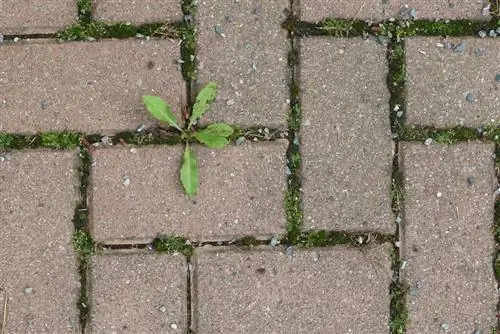- Author admin [email protected].
- Public 2023-12-17 03:39.
- Last modified 2025-01-24 12:45.
Weeds don't stop at the joints between paving stones. Countless species find optimal conditions here in particular. Once a weed has grown, it usually doesn't take long until it multiplies, other weeds grow and spread rapidly over many meters in the paving stone joints. Weed control is not one of the most popular activities, especially between paving stones. Here you will find out which methods work more quickly or less quickly, what you shouldn't do and how you can intelligently prevent it.
Home remedies
If you don't want to rely on chemical products, you can tackle the weeds in the joints of paving stones with simple home remedy tricks. But be careful, because weed killer substances are also hidden here, the use of which is only permitted to a limited extent and can result in extremely expensive pen alties if ignored.
Weeding
The gentlest, but probably also the most strenuous way to destroy weeds is to pull them out by hand. Pulling out a weed here and there as you pass by is certainly the most convenient method, but not the most effective, as weeds that remain standing continue to multiply. You will only have long-term success here if you meticulously pull out all the weeds in the stone joints within a short time frame.
You can simplify weeding with a joint scraper that has been specially developed for controlling weeds in narrow gaps. They clearly protect your fingers. So-called telescopic weed cutters, into which a joint scraper can also be inserted, are ideal. With this device you no longer need to bend over, protect your back and can reliably completely remove roots that are firmly anchored in the ground with a narrow weed cutter.
Tip:
Roots are easier to completely remove from the paving stone joints if the soil in the cracks is well soaked. The water should be given about an hour to reach deep into the soil before you start weeding.
cooking water
Using boiling hot water, you can effectively destroy weeds in the stone joints if they are shallow-rooted and delicate species, such as:
- Common Yarrow (Achillea millefolium)
- Young bearpod (Astragalus glycyphyllos)
- Canadian Fleabane (Conyza canadensis)
For dandelions, thistles or similar, this method of weed destruction is only suitable if they are small young plants whose shoots are still thin and roots are not yet strengthened.
Boiling water destroys the fine plant structure and causes it to collapse. Depending on the type of weed, this process usually takes between two and four days. You may have to pour hot water several times, which ultimately speeds up the dying process. Since the joints between paving stones are usually really narrow, a little skill is required to allow the water to flow in sufficiently so that the roots can also be reached.
High-pressure cleaner
You can only achieve a promising result with a high-pressure cleaner if you use it with at least 100 bar and hold it directly into the joints. Most types of weeds have shallow roots and can usually be pushed out quite easily thanks to the high water pressure. However, with the high-pressure cleaner you also lift earth or gravel out of the joints, which is not advantageous, especially with wider joints. Therefore, this method is only recommended for joints up to a maximum of three millimeters.
Burning
A very common way of killing weeds is burning. This is less possible with a conventional camping gas burner. There are special gas burners with an integrated gas cartridge for this purpose, which are available from specialist retailers or hardware stores. Here you hold the flame on the weed for a few seconds until it has burned down. Then aim well into the joints so that the flame also reaches the root. The root core is always in the upper area. If this is burned, the root can no longer grow and the rest can remain in the ground. A subsequent removal is therefore not necessary.
Tip:
Always wear safety glasses when using a burner as a weed killer because small sparks can form and hot plant particles can fly around. If these get into your eyes, this can result in serious damage.
Weed Killer Law
Although vinegar and s alt in appropriate concentrations are known for their extreme effectiveness against weeds, their use to kill weeds on “unsealed areas” is PROHIBITED by law. “Unsealed surfaces” include paving stone surfaces that do not have a sealing protective layer and thus allow moisture to penetrate into the soil.

This is regulated by the Plant Protection Act, which states that vinegar and s alt as weed killers require a high concentration and thus pose an environmental hazard due to the inability to biodegrade.
In short this means:
You must not use these “home remedies” on your paved terrace, driveway or other places with access to the ground, otherwise you could face a fine of up to 50,000 euros.
Chemical weed killer
The range of chemical weed killers is wide-ranging. The handle is quickly turned into an unsuitable product.
Just as with weed control with vinegar and/or s alt, there are also chemical weed killers that, if used in the wrong locations, could have criminal consequences due to a violation of environmental and/or plant protection law. For example, there are numerous weed killers for lawns that are absolutely unsuitable for weeds in the joints of paved surfaces.
If a weed killer is suitable for joints between paved surfaces, it is still not automatically applicable everywhere. For example, terraces surrounded by lawn offer different environmental conditions than walkways that directly border a pond. Here it is important to pay close attention to the areas of application of each weed killer.
There is a range of products for joints between paving stones specifically designed for each different environmental condition. The most effective and therefore most widespread weed killers include those that contain glyphosate. However, we strongly advise against this! Glyphosate is controversial because it is suspected of being carcinogenic. Please protect yourself and those around you from the harmful effects of chemical agents.
Prevention
Bud cutting
Wherever you see seed weeds in the area, you should act immediately and immediately cut off any buds that may be present before they reach seed maturity and the seeds are carried into paving stone joints by the wind or birds. In this way you at least prevent excessive spread and provide a high level of weed control.
Root Weed
If root weeds have already established themselves in your garden or in a joint on paving stones, they should of course be removed immediately or killed using weed killers. In most cases, weeds can still be pulled out of the cracks even after they have died and are then usually disposed of in the compost. Mistake! Not always the root is completely killed. If this is then disposed of in a compost heap, the still partially living roots receive plenty of nutrients to stimulate root growth again. For this reason, you should never throw root weeds into the compost heap, but instead dispose of them in the trash.

gravel
The best precautionary measure is to choose the optimal substrate when planning paving stones. What is most common here is a deep layer of gravel or gravel, which should be at least 25 centimeters long before it is “compressed” into a dense, smooth layer. This makes it difficult for many types of joint weeds to form roots in the soil.
However, there are also some types of weeds that do not require soil, such as moss. This then forms an excellent basis for the growth of further weeds. But as a rule, with an appropriately thick layer of gravel or gravel under the paving stones, you should have peace of mind from weeds in the joints for the first few years.
Weed fleece
In addition to the gravel, a special weed fleece promises long-term prevention against weeds in the joints. This is placed on top of the gravel or gravel layer before paving. High-quality fleeces last for decades and are so densely networked that it is almost impossible for roots or other plant parts to get through. But it still allows moisture to seep through.
Joint closure
Gravel, earth or sandy mortar is usually used to close the joints in paving stones. However, this is less advisable for weed prevention. There is a special paving joint mortar that seals the joints significantly more, but still retains water-permeable properties. If you want to be on the safe side, use a joint mortar that is completely impermeable to water and therefore does not offer any attack surface for seeds or roots.
However, this has the disadvantage that rainwater can collect on the paving if the paving is not exactly at a level that allows the water to drain away evenly. By the way, grout can also be applied afterwards.
Vinegar cleaning
Although vinegar is prohibited as a weed killer on paved paths, a vinegar cleaner or vinegar-water mixture can be used in a lower concentration and serve to prevent weeds. If you use vinegar to clean the paving stones regularly, you can remove even the smallest weeds with the finest structure. It is ideal if you use a robust scrubber or hard broom when cleaning, so that you can safely remove stuck seeds from the stones, for example. During the summer months, cleaning with vinegar is recommended approximately every two weeks. But make sure that you only use as much vinegar cleaner as for normal cleaning.
Sealing
When sealing, the paving stones are completely covered with a protective film. However, sealed joints are necessary for this. The sealing not only makes the paving stones look like new for a long time, but it also ensures that no green plants settle on them or in the joints.
Conclusion
Fighting weeds in the joints between paving stones is generally an unpopular activity. There probably won't be general weed protection for eternity, but thanks to effective methods such as those described here, you can at least choose the most optimal option for yourself and, with some applications, weed-free paving for an entire summer and depending on the prevention, also for many years. These advice and tips will save you time, money and unnecessary effort.






